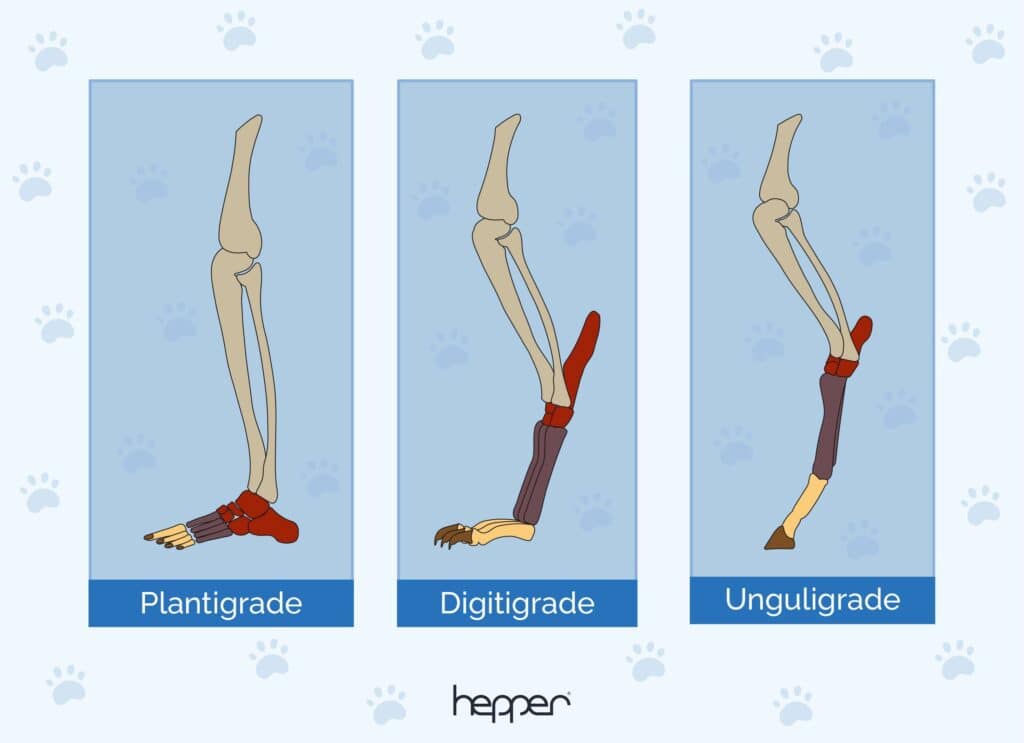What Does Digitigrade Mean? Vet-Approved Explanation (With Infographic)
Updated on

Digitigrade is a common characteristic of mammals and birds, but it does not encompass all species of either class of animals. Humans, baboons, and bears are notable exceptions to the former. Grebes and loons are standouts for the latter. Scientists coined the word in 1819 from the Latin digitus (toe) and gradi (to walk) to mean “walking on the toes with the heel raised from the ground.”
Types of Foot Postures

The common ancestor of mammals was plantigrade, meaning “walking on the whole sole of the foot” as opposed to just the digits. The advantage of this foot posture was an edge in fighting. Remember that in nature, you’re either prey or predator. Locomotion makes the difference between getting caught or getting fed. It’s also critical in the development of other anatomical features.
In addition to digitigrade and plantigrade is the unguligrade posture. These animals walk on the tip of their toes (hooves), which are adaptations of only one or two digits. Interestingly, research has revealed limited paths in diversification. Plantigrades evolved only into digitigrades. Unguligrade only transitioned from digitigrades.
It’s evident why evolution would take this course when you consider the anatomy of the lower body. Variations in the skeletal anatomy support the advantages each type affords. However, the foot posture is only the beginning of the story.
Evolution of Foot Postures
Speed is the name of the game, whether you’re prey or a predator. Being a digitigrade is a clear advantage from this perspective. From an anatomical point of view, ramping things up can occur through two routes.
An animal can increase its stride rate by reducing limb mass. It can then move its limbs to and fro faster. The other way an animal can move quicker is with longer limbs which increases the stride length. More ground is covered in each step. Ungulate herbivores, like deer and antelopes, are classic examples. The pronghorn and springbok are among the fastest mammals on Earth.3 Not surprisingly, the top animal is the Cheetah, a long-limbed digitigrade.
Advantages of Various Foot Postures
The clear advantage of foot posture lies with locomotion and how an animal’s speed factors into the equation. Changes in stride rate often involve what scientists call “the economy of walking or running.” The terms describe the effort and energy required for the movement. Decreasing the distance between the center of gravity and the length of the limb means less effort and better energy utilization.
Anatomy also plays a role in the arrangement of muscles, bones, ligaments, and tendons. The insertion points of muscles into joints affect the balance between power and speed. It’s also evident in the position of the bones in the limbs. An angle between the upper and lower bones exists in digitigrades and ungulates, which capitalizes on the momentum they can achieve.
Therefore, we can conclude speed is vital for both the hunter and the hunted. Other adaptations help conserve energy and optimize locomotion. Humans pose an interesting riff on this evolutionary advantage. As we’ve discussed, we are plantigrades and walk on the soles of our feet, which helps us with endurance running. Stamina and environmental adaptability help us with this activity.
However, it’s worth noting that the fastest humans move away from being plantigrades toward assuming a digitigrade posture when running1. The different position gives them the same advantage as mammals with this foot posture. Therefore, we can think of digitigrades as making the most of speed.

Cats Versus Dogs
We’d be remiss not to address the differences between two familiar digitigrades, cats and dogs. Both animals make the most of speed as predators. They have pads, which improve their stability over the ground. However, felines get the nod when it comes to their various specializations. Cats have retractable claws that allow them to respond to the running surface. They are also powerful weapons.
Felines rely on stealth to stalk and capture prey. Retractable claws make it possible to sneak up on their quarry without tipping them off with their nails clicking against a hard surface. As all cat owners know, feline claws serve other purposes with communication by scratching on trees or other surfaces, whether or not they’re appropriate as pets. It’s instinctive to them.
Both animals use their feet for other tasks, like digging or covering up prey. Being digitigrade adds to these abilities, even if they serve disparate purposes. They show the versatility this foot posture gives to these species.
Of course, dogs and cats walk on all four limbs, making them quadruped. Being quadruped and digitigrade means other skeletal differences to optimize speed through stride rate and length. We can see it in the flexibility and stability of their joints. Felines epitomize speed with other adaptations, such as their flexible spine and shoulder blade attachment via muscles instead of bone. After all, cheetahs are the fastest animal.
Feline anatomy allows them to lengthen their stride with their digitigrade foot posture, giving them the edge. Their forelimbs shoulder about 60% of their weight. Their role is to absorb the impact while the hindlimbs provide the thrust. Interestingly, cats can be left or right-pawed. You’re more likely to see a preference when they take their first step or reach for food. Dogs show a similar lateral bias.

Birds
Birds are a different story when it comes to locomotion. Of course, the forelimbs allow them to fly. Most species walk on land, although loons have a tougher time getting around out of water. While they are mainly digitigrade, you’ll see many variations. For example, songbirds, like finches and sparrows, have three toes pointing forward and one back. Perching is their resting position.
On the other end of the spectrum are the webbed feet of ducks and other waterfowl. That structure, along with their position toward the back of their bodies, allows them to move freely through the water. Gulls also have this anatomical feature. Its purpose isn’t just swimming; it also helps them walk in sand without sinking.
Birds use their feet for other tasks. Think of a cockatiel holding a sprig of millet or a parrot grasping onto a peanut. There are also the sharp, albeit deadly talons of hawks and owls used for grabbing and killing prey.
Woodpeckers are another riff on being digitigrade with their zygodactyl feet. That means they have two toes pointing forward and two back. This arrangement allows them to climb trees quickly. Parrots also have this adaptation for the same reason.

Final Thoughts
Being a digitigrade puts speed in your court. It allows you to run faster to catch your dinner or evade a predator. It’s a later adaptation from the plantigrade foot posture mammals had in the beginning. The fascinating thing is its effects on an animal’s anatomy. The skeletal structure changes are based on how the foot hits the ground. It provides another fascinating contrast between humans and other mammals.
Featured Image Credit to: SingjaiStocker, Shutterstock












